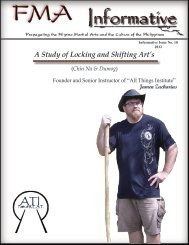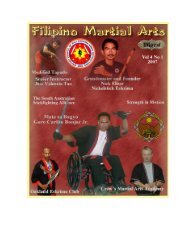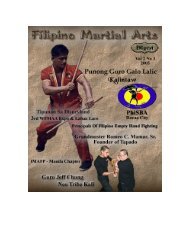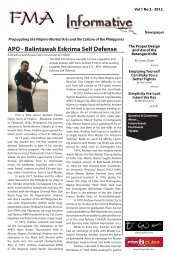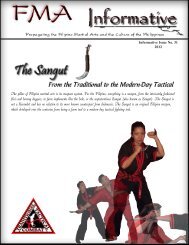Tournaments - FMA Informative
Tournaments - FMA Informative
Tournaments - FMA Informative
You also want an ePaper? Increase the reach of your titles
YUMPU automatically turns print PDFs into web optimized ePapers that Google loves.
In order to get an understanding of Balintawak, we decided to attend a few<br />
sessions of a Balintawak class. Fortunately, there was no need to go to Cebu because Bob<br />
Silver Tabimina, one of the top students of Anciong Bacon and one of the most respected<br />
Balintawak teachers around, holds classes in manila.<br />
Tabimina is one of the few Filipino martial arts teachers alive who has an actual<br />
fight record – a fight record that has made its way through the collected mythology of<br />
Filipino martial arts. Believe it or not, there are martial arts teachers out there who know<br />
the techniques but have never been in a fight, much less full-contact matches.<br />
So when we finally met the man, we just had to ask: What kinds of injuries were<br />
sustained in these matches, and did anybody ever really die in a match?<br />
“Well, some of the injuries were serious,” Tabimina, says. “Some fighters got<br />
knocked out, got bones broken. One time, a fighter’s eye supposedly popped out and<br />
dropped to the ground.”<br />
Whoa. So the scenes where Daryl Hannah’s character in Kill Bill-2 ended up<br />
losing both eyes in two separate fights – first with Master Pai Mei then with Uma<br />
Thurman’s character – might have some real basis. Let’s make it clear, though, that the<br />
eye-popping incident was only told to Tabimina by Anciong Bacon.<br />
So the question remains… did anybody ever die?<br />
“You know, not all stories about fighters getting, killed are accurate,” the master<br />
says. “You have to remember that most of these so-called death matches were a matter of<br />
ego. Ego drove the challengers to pick a fight, and ego made those who were challenged<br />
agree. A lot of times, even though a losing fighter needed to go to the hospital for<br />
treatment, the fighter would refuse to go because of pride. Of course, among the fighters<br />
going around with untreated internal injuries, a few would die some weeks later from<br />
internal bleeding, etc.”<br />
Tabimina said the fighting culture was very different during the 1950s until the<br />
1970s, when a gentlemen’s agreement could free a winning fighter from legal and other<br />
obligations in the event that a losing fighter got seriously injured or even died as a result<br />
of a full-contact match.<br />
“People became a lot smarter in the 1980s. For one thing, the fighters and their<br />
relatives had become more aware of the rights and of the legal questions involved in a<br />
full-contact fight. So eventually, nobody would agree to such full-contact matches.”<br />
Tabimina explains.<br />
The ambush attack that ultimately landed<br />
Anciong Bacon in jail, however, is no myth. In fact,<br />
Tabimina learned Balintawak from Anciong Bacon<br />
in Camp Crame, where Bacon served part of his<br />
sentence and taught his fighting art to<br />
members of the Metrocom. It was Tabimina<br />
who took care of Bacon’s personal needs while<br />
Bacon served his sentence. In return, Bacon taught<br />
Tabimina the many modifications in Balintawak that the<br />
old man had created.<br />
“Bacon had modified Balintawak, refining it<br />
more in his old age and while he was in prison,” attests<br />
Tabimina. “To be honest, I thought I was a formidable fighter before I met Bacon. I had



